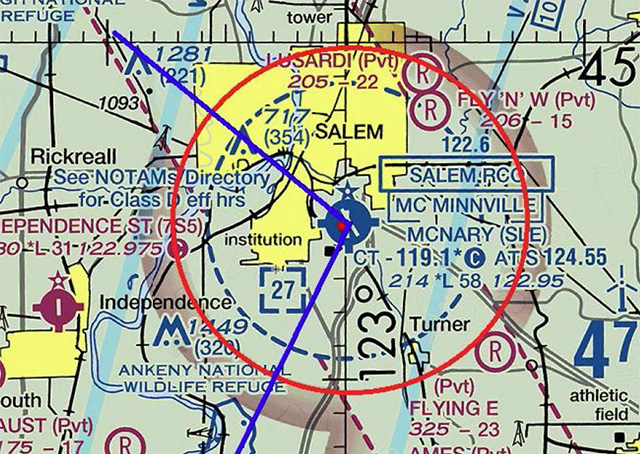AOPA helps Oregon pilots with Class D relief

Salem, Oregon, pilots operating at Independence State Airport should soon get some airspace relief after AOPA communicated numerous concerns to the FAA’s Western Service Center to mitigate the Class D airspace expansion at neighboring McNary Field Airport. AOPA’s letter to the FAA on Sept. 8, along with letters sent by local pilots and the Oregon Pilots Association, protested recent Salem airspace changes that doubled its size and severely affected neighboring Independence State to the city's west.
One of the requests in AOPA’s comments was for a letter of agreement to be completed as soon as possible between Salem air traffic controllers and the pilots operating in and out of Independence State Airport. It is one of the busiest general aviation airports in Oregon, with 200 hangar-homes and a comparable number of aircraft based there, said Rune Duke, AOPA director of government affairs for airspace and air traffic. Because of the new airspace, pilots at Independence State Airport have less time to communicate on the common traffic advisory frequency, and air traffic is squeezed closer to the field. A larger footprint for Independence State Airport would increase safety, Duke said, because high terrain and communication issues are amplified by the close proximity of the Salem Class D boundary.
The FAA responded with an agreement that would reduce the Class D surface area for those pilots operating at Independence State Airport and move its cutout back to the ridge line, Duke said. The relief would allow pilots to operate similarly to how they did prior to the Class D expansion. The Sept. 17 agreement was updated Sept. 25, and is valid only when Salem airport experiences VFR conditions. The agreement will be canceled following permanent changes to the Class D surface area, when it will be made smaller. The exact dimensions will be provided during the forthcoming rulemaking process.
Pilots involved in Christmas tree farming near Independence State also have been hit hard since Aug. 20 when the Salem Class D footprint expanded to about 16 nautical miles across. Duke met with the FAA’s airspace staff to discuss the letter and request greater relief for agricultural operations. He explained that the increased airspace protection at McNary Field negatively affects agricultural pilots because they can’t fly their helicopters or airplanes to harvest or spray the Christmas tree crops when McNary Field experiences instrument flight rules conditions.
“Thousands of acres of Christmas trees lie under the new Class D airspace and farmers rely heavily on aircraft for aerial application processes and particularly on helicopters for harvesting the trees,” said Duke. “The weather in this area can be dramatically different just a few miles away. If McNary Field is under IFR conditions, then the number of aircraft allowed within the Class D surface area is limited. This facility does not have radar, so to ensure adequate separation only one aircraft at a time may be allowed within the entire Class D area. This means farming tasks within the newly expanded Class D area may be severely delayed during any bad weather. Several operators and farmers have filed comments with the FAA asking for relief due to the economic impacts any delay would impose on getting these popular evergreens to the market.”
The FAA said a review of the Salem airspace revealed an increase and reconfiguration was needed to protect IFR procedures for McNary Field’s Runway 13/31, with rising terrain factoring into the unusually large airspace changes.
After the changes were published without comment in August, Duke spoke with the air traffic manager at the Salem tower about the new boundaries and about getting the word out to pilots flying in the scenic Willamette Valley corridor. As a result of those conversations, controllers are broadcasting the recent airspace changes during hourly ATIS reports.
AOPA provided formal comments to the FAA on Sept. 8 regarding the McNary Field Class D design, Duke said. The association asked the agency to revert to the currently charted Class D design because the Seattle sectional chart will not depict the change until its Dec. 10 update. The association also requested a larger cutout for Independence State to increase the safety factor for pilots, and replacement of Class E airspace to accommodate tree farmers' operations, along with notices to airmen for both airports.
“The FAA failed to effectively communicate the proposal to local aircraft operators, airports, and even air traffic control,” wrote Duke. “There are significant safety implications because Salem air traffic controllers were not included in the design process or notified of the changes until after they were in effect.”



